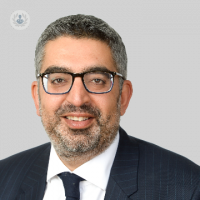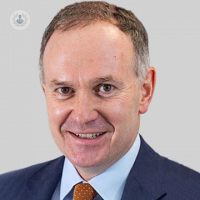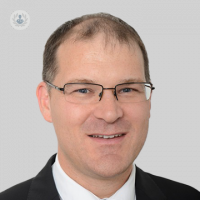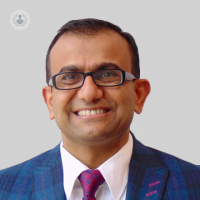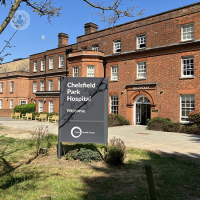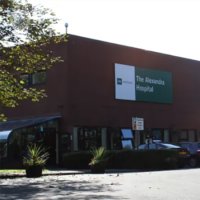What is it?
Trigger finger is a condition that affects the tendons that bend the fingers. When the tendon sheath is inflamed, it makes finger extension or flexion difficult. This can cause the fingers to lock or trigger suddenly. The medical term for it is tenosynovitis. Orthopaedic specialists are devoted to preventing, diagnosing, and treating musculoskeletal conditions such as trigger finger.
Prognosis
It is not common for trigger finger to spontaneously resolve. If it is not treated, it is likely to be a painful discomfort. If the finger gets trapped, it could cause permanent stiffness.
What are the symptoms?
Trigger finger symptoms may start with discomfort at the base of the finger, which could cause inflammation and swelling.
The most common symptoms are:
- A small lump in the palm of the hand, normally around the trochlea.
- Inflammation.
- Finger joint pressure or paralysis.
- Pain when flexing or extending the finger.
Medical tests
The diagnosis can normally be made based on the patients’ medical history and symptoms. A physical exam is normally carried out to assess the stiffness and sensitivity of the affected fingers. The doctor may choose to do an ultrasound to check the swelling or they may carry out specific tests if they think it may be related to a different condition.
What causes trigger finger?
There is no clear cause for this condition, but it is thought to be related to rheumatoid arthritis, gout, or diabetes. It is more common in women and people aged between 40 and 60 years old. People who regularly carry out activities that require repetitive phalange flexion and extension for long periods of time, or put intense external pressure on a finger, are more likely to be affected by trigger finger.
How can it be prevented?
Tenosynovitis can only partially be prevented. If it is due to an underlying condition (rheumatoid arthritis for example) that causes thickening of the finger tendon sheaths and causes involuntary movements and pain, it should be treated before it causes trigger finger. It may also be caused by a tendon mechanical overload. Certain movements should be avoided, and exercises should be carried out to strengthen the tendons.
Recommendations include:
- Limit repetitive or forced finger activities
- Alternate activities
- Rest between tasks
- Try to not force movement
- Regularly exercise fingers and palm.
What is the treatment?
Trigger finger treatment normally involves alleviating tendon pressure and enabling finger movement without any discomfort. A splint or anti-inflammatory medications are often used. If these treatments don’t work, surgery may be resorted to.
11-13-2012 07-19-2023
Trigger finger
What is it?
Trigger finger is a condition that affects the tendons that bend the fingers. When the tendon sheath is inflamed, it makes finger extension or flexion difficult. This can cause the fingers to lock or trigger suddenly. The medical term for it is tenosynovitis. Orthopaedic specialists are devoted to preventing, diagnosing, and treating musculoskeletal conditions such as trigger finger.
Prognosis
It is not common for trigger finger to spontaneously resolve. If it is not treated, it is likely to be a painful discomfort. If the finger gets trapped, it could cause permanent stiffness.
What are the symptoms?
Trigger finger symptoms may start with discomfort at the base of the finger, which could cause inflammation and swelling.
The most common symptoms are:
- A small lump in the palm of the hand, normally around the trochlea.
- Inflammation.
- Finger joint pressure or paralysis.
- Pain when flexing or extending the finger.
Medical tests
The diagnosis can normally be made based on the patients’ medical history and symptoms. A physical exam is normally carried out to assess the stiffness and sensitivity of the affected fingers. The doctor may choose to do an ultrasound to check the swelling or they may carry out specific tests if they think it may be related to a different condition.
What causes trigger finger?
There is no clear cause for this condition, but it is thought to be related to rheumatoid arthritis, gout, or diabetes. It is more common in women and people aged between 40 and 60 years old. People who regularly carry out activities that require repetitive phalange flexion and extension for long periods of time, or put intense external pressure on a finger, are more likely to be affected by trigger finger.
How can it be prevented?
Tenosynovitis can only partially be prevented. If it is due to an underlying condition (rheumatoid arthritis for example) that causes thickening of the finger tendon sheaths and causes involuntary movements and pain, it should be treated before it causes trigger finger. It may also be caused by a tendon mechanical overload. Certain movements should be avoided, and exercises should be carried out to strengthen the tendons.
Recommendations include:
- Limit repetitive or forced finger activities
- Alternate activities
- Rest between tasks
- Try to not force movement
- Regularly exercise fingers and palm.
What is the treatment?
Trigger finger treatment normally involves alleviating tendon pressure and enabling finger movement without any discomfort. A splint or anti-inflammatory medications are often used. If these treatments don’t work, surgery may be resorted to.


Is trigger finger linked to arthritis and diabetes?
By Mr G Shyamalan (Shyam)
2024-11-21
Have you ever wondered what exactly trigger finger is and whether or not it is connected to arthritis or diabetes? Experienced consultant hand surgeon, Mr G Shyamalan (Shyam), provides a detailed description of what this condition is, and tells us what the first line of treatment should be when seeking to cure this medical condition. See more
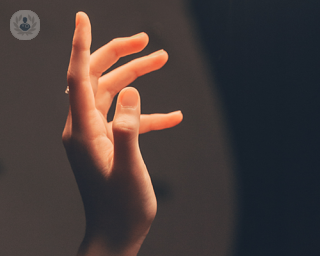

Hand surgery: The last resort in a series of treatments
By Mr Andreas Baumann
2024-11-21
The general term for various surgical procedures which aim to reduce pain and restore function in the hand, wrist or forearm is hand surgery. Highly-regarded consultant hand and shoulder surgeon Mr Andreas Baumann offers an expert insight into the area. He explains exactly what hand surgery involves, the potential complications and what recovery is like following surgery, among other important points. See more
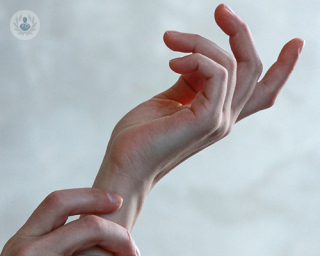

Trigger finger surgery explained by a specialist
By Mr Stephen Lipscombe
2024-11-20
Sometimes, surgery is necessary to cure a trigger digit. Dr Stephen Lipscombe explains when surgery for trigger finger or trigger thumb is necessary, what to expect from the procedure and its success rate. See more


Trigger finger: causes, symptoms and treatment
By Ms Anna Moon
2024-11-19
Trigger finger can lead to the fingers locking into a bent position, which can feel very tender and painful. We spoke to one of our top hand surgeons Ms Anna Moon all about the condition, from the symptoms and causes to treatment options. See more
Experts in Trigger finger
-
Mr Kunal Hinduja
Orthopaedic surgeryExpert in:
- Hand surgery
- Dupuytren’s contracture
- Hand injury
- Carpal tunnel surgery
- Trigger finger
- Ganglion cyst
-
Mr Patrick Gillespie
Plastic surgeryExpert in:
- Warts
- Carpal tunnel syndrome
- Dupuytren’s contracture
- Skin cancer
- Cysts
- Hand arthritis
-
Mr G Shyamalan (Shyam)
Orthopaedic surgeryExpert in:
- Carpal tunnel surgery
- Dupuytren’s contracture
- Trigger finger
- Hand surgery
- Ganglion cyst
- Epicondylitis (tennis elbow)
-
Mr Andrew Logan
Orthopaedic surgeryExpert in:
- Carpal tunnel syndrome
- Dupuytren’s contracture
- Wrist surgery
- Trigger finger
- Hand arthritis
- Hand surgery
-
Mr Ravi Badge
Orthopaedic surgeryExpert in:
- Carpal tunnel syndrome
- Cubital tunnel syndrome
- Trigger finger
- Thumb Osteoarthritis
- Epicondylitis (tennis elbow)
- Rotator cuff injury
- See all

Cleveland Clinic London Hand Unit
Cleveland Clinic London Hand Unit
33 Grosvenor Place
No existe teléfono en el centro.
By using the telephone number provided by TOP DOCTORS, you automatically agree to let us use your phone number for statistical and commercial purposes. For further information, read our Privacy Policy
Top Doctors

Chelsfield Park Hospital - part of Circle Health Group
Chelsfield Park Hospital - part of Circle Health Group
Bucks Cross Rd, Chelsfield, Orpington BR6 7RG
No existe teléfono en el centro.
By using the telephone number provided by TOP DOCTORS, you automatically agree to let us use your phone number for statistical and commercial purposes. For further information, read our Privacy Policy
Top Doctors

The Alexandra Hospital - part of Circle Health Group
The Alexandra Hospital - part of Circle Health Group
Mill Ln, Cheadle
No existe teléfono en el centro.
By using the telephone number provided by TOP DOCTORS, you automatically agree to let us use your phone number for statistical and commercial purposes. For further information, read our Privacy Policy
Top Doctors
-
Cleveland Clinic London Hand Unit
33 Grosvenor Place, Central LondonExpert in:
- Arthritis
- Hand surgery
- Diagnostic Imaging
- Musculoskeletal imaging
- Hand and wrist
- Joint replacement
-
Chelsfield Park Hospital - part of Circle Health Group
Bucks Cross Rd, Chelsfield, Orpington BR6 7RG, OrpingtonExpert in:
- Vascular Surgery
- Cardiology
- Colorectal surgery
- General Surgery
- Maxillofacial Surgery
- Orthopaedic surgery
-
The Alexandra Hospital - part of Circle Health Group
Mill Ln, Cheadle, CheadleExpert in:
- Hip
- Cardiology
- Shoulder and elbow
- Paediatrics
- Foot and ankle
- Knee
- See all
- Most viewed diseases, medical tests, and treatments
- Migraine
- Joint pain
- Lumbar herniated disc
- Spinal surgery
- Minimal access surgery (keyhole surgery)
- Head and neck cancer
- Neck lump
- Acellular dermal matrix (ADM)
- Prepectoral breast reconstruction
- One Stop Breast Clinic
